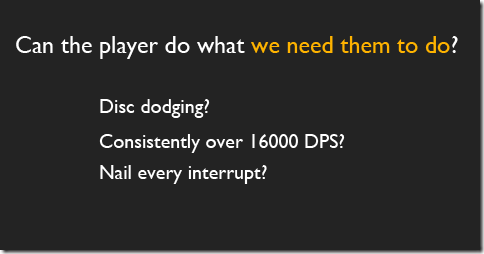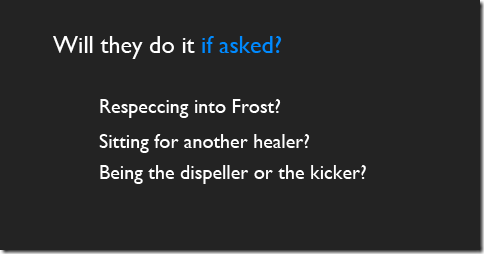This is a guest post by Valen who has graciously offered to clarify the EPGP loot system and the process behind the usage.
Hello! I am Valen, Guild Leader of Temerity, an efficiency-focused progression guild on the Windrunner server. I also happen to be helping maintain EPGP while its author, Disht of EU-Sunstrider, takes a well-deserved break. My hope is to provide an introduction to EPGP and demonstrate why many people believe it to be a superior loot system.
What is EPGP?
The EPGP loot system, nicknamed “dkp reloaded,” is a mature, established loot system that has been in active use by many guilds for a number of years. Sometimes known for being somewhat “mathy,” EPGP tries to provide a fair, transparent, configurable, deterministic, and reasonable loot distribution system. EPGP is somewhat more complicated than most loot systems, but thanks to addons that simplify calculations and management, both the master looter and all members of a guild will find EPGP to be a fluid and effective loot system.
The word “fair” is somewhat ambiguous when it comes to handling loot, and is highly subjective. Can loot systems be fair to every member of a guild, and to the guild itself? Probably not, but when people think about fair loot systems, often words like “unbiased” are used, with sentiments of objective, even distribution. EPGP provides such features.
Many familiar loot systems, such as DKP and its variants, use a single point pool, whereas EPGP uses two. Those two kinds of points in EPGP are in the name — EP and GP. EP, which stands for Effort Points, encapsulates the contributions of a raider to the raid (primarily attendance). GP, which stands for Gear Points, encapsulates the loot a raider has received from the raid.
How does it work?
Dividing a raider’s EP by their GP determines a raider’s Priority. When a piece of loot drops, the player who is interested in it with the highest Priority gets the loot along with the Gear Points the loot is valued at — there is no randomness or rolling in EPGP. This therefore increases the player’s GP, which lowers their priority once the division takes place, putting them below many other players (depending, of course, on the other players’ EP and GP values).
Left unchecked, EP, which grows as raids are attended, and GP, which grows as loot is received, would increase unbounded since neither are reduced inherently in the loot process. Instead of spending points, both simply accumulate. To prevent infinite growth, EPGP uses the concept of decay — at the start of every raid, or every raid week, or any other interval, everyone’s EP and GP are reduced by a fixed percentage. This results in EP climbing quickly at first, but then eventually sloping off towards a natural cap. GP, on the other hand, tends towards zero as it accumulates only when loot is rewarded rather than every raid.
The above is intentionally vague and lacking in specific numbers. This is one of the areas where EPGP is configurable to meet a given guild’s needs, but also where it tends to intimidate users.
- How much EP does a raider get?
- What earns EP?
- How much GP does a piece of loot cost?
The latter question is the easiest to answer; by default, every piece of loot has a fixed cost across all guilds and servers, based on the slot it is used in and the item’s level (aka, ilvl). Deep inside the game, there are formulas used to determine how much of a each stat such as Haste Rating or Intelligence a piece of gear has; this formula is based on the ilvl and slot, so, for instance, an ilvl 359 two handed sword has more strength than an ilvl 359 one handed sword or ilvl 359 ring. EPGP uses this formulation to derive a price for each piece of loot, normalizing around a chest piece with an arbitrary cost of 1,000 GP. Weapons cost more than 1,000 GP since they have a bigger impact than a new chest, whereas rings, carrying smaller item budget, cost less.
EP is more fluid; typically guilds award EP based on attendance, both who is present at the beginning of raid and who is present throughout its duration. Even players on the bench receive EP and thereby loot opportunities when next they are in raid.
EPGP in action
Each guild decides themselves how much EP to award and what to award for, so rather than a complicated explanation, I will use a concrete example and explain how my guild uses it.
Fifteen minutes before raid starts, a decay of 7% occurs. Then an on-time bonus of 1,250 EP is awarded to each member in the raid. Every fifteen minutes thereafter until the end of raid, 300 EP is awarded to anyone in the raid and on standby. Finally, at the end of raid, another 1,250 EP bonus is awarded. The net result is a typical, 3.5 hour night of raiding results in 7,000 EP.Some guilds opt to also award EP when bosses die (with different amounts of EP depending on the farm status of the boss) but we choose to not award the kills themselves.
The values chosen are largely arbitrary; we settled on a 7% decay as it is a decent rate to prevent hoarding as well as to encourage taking loot (since GP will decay at a decent rate). We chose 7,000 EP per raid because it has the mathematical property that, a player with perfect attendance across an infinite number of raids, would cap out at 100,000 EP — the point where a 7% decay equals the EP awarded for the evening (7% of 100,000 is 7,000, of course).
We also choose to award a small, fixed weekly amount of EP for consumables — specifically, raw herbs and fish. This was a new experiment for us as early Cataclysm consumables were extremely expensive until supply grew and guild perks kicked in, this helped us supply flasks and feasts — a significant competitive advantage.
The EPGP system itself is managed via the EPGP addon. Earlier I mentioned that EPGP is transparent; this means, thanks to the addon, any player can see any other player’s standing and priority from within the game. In fact, this addon keeps all EPGP state in-game rather than on an external website. Therefore, it is never a surprise when someone receives loot as any player can, at any time, see other players’ EP, GP, and Priority. Likewise, the addon places the GP cost to every item in its tooltip, so you know the exact price an item would cost by simply mousing over it.
In addition to the EPGP addon itself, there is a third party addon named EPGP Lootmaster. This addon handles the loot process itself, providing very simple push-button distribution and vastly reducing the time it takes to handle the many drops off of the typical 25 man heroic boss. I highly recommend using both addons together for a tremendously smooth and simplified loot process.
Hopefully this has provided a relatively math-free explanation of EPGP. I’ve personally used it for over four years, and while certainly imperfect, it is an excellent combination of transparency, fairness, and efficiency that is suitable for guilds at all levels of progression. Once the initial setup is done, there is very little maintenance and the distribution of loot itself is very quick — important attributes for efficient raiding!
Further resources
EPGP’s website, mailing list, and bug forum
The addon itself
The Lootmaster Addon


